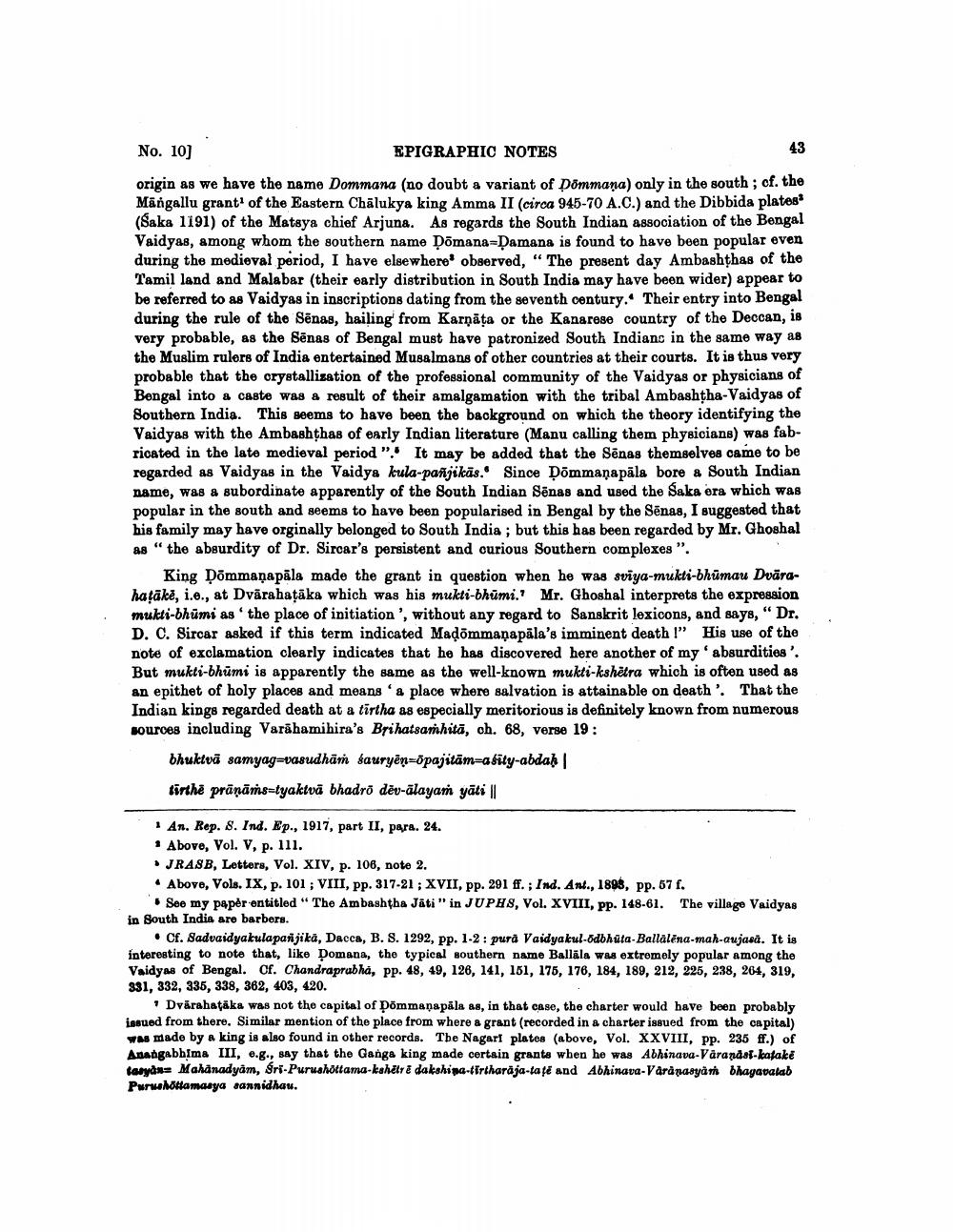________________
No. 10)
EPIGRAPHIC NOTES
43
origin as we have the name Dommana (no doubt a variant of Dommana) only in the south ; cf. the Māngallu grant of the Eastern Chālukya king Amma II (circa 945-70 A.C.) and the Dibbida plates (Saka 1191) of the Matsya chief Arjuna. As regards the South Indian association of the Bengal Vaidyas, among whom the southern name Domana Damana is found to have been popular even during the medieval period, I have elsewhere observed, “The present day Ambashţhas of the Tamil land and Malabar (their early distribution in South India may have been wider) appear to be referred to as Vaidyas in inscriptions dating from the seventh century. Their entry into Bengal during the rule of the Sēnas, hailing from Karşāta or the Kanarese country of the Deccan, 18 very probable, as the Sēnas of Bengal must have patronized South Indians in the same way as the Muslim rulers of India entertained Musalmans of other countries at their courts. It is thus very probable that the crystallization of the professional community of the Vaidyas or physicians of Bengal into a caste was a result of their amalgamation with the tribal Ambashţha-Vaidyas of Southern India. This seems to have been the background on which the theory identifying the Vaidyas with the Ambashţhas of early Indian literature (Manu calling them physicians) was fabricated in the late medieval period ". It may be added that the Sēnas themselves came to be regarded as Vaidyas in the Vaidya kula-pañjikās. Since Dommaņapāla bore & South Indian name, was a subordinate apparently of the South Indian Sēnas and used the Saka ora which was popular in the south and seems to have been popularised in Bengal by the Sēnas, I suggested that his family may have orginally belonged to South India ; but this has been regarded by Mr. Ghoshal as "the absurdity of Dr. Sircar's persistent and curious Southern complexes".
King Dommaņapāla made the grant in question when he was sviya-mukti-bhūmau Dvārahatākë, i.e., at Dvārahatāka which was his mukti-bhūmi.? Mr. Ghoshal interprets the expression mukti-bhumi as the place of initiation', without any regard to Sanskrit lexicons, and says, "Dr. D. C. Sircar asked if this term indicated Madõmmaņapāla's imminent death !" His use of the note of exclamation clearly indicates that he has discovered here another of my absurdities'. But mukti-bhumi is apparently the same as the well-known mukti-kshetra which is often used as an epithet of holy places and means ' a place where salvation is attainable on death'. That the Indian kings regarded death at a tirtha as especially meritorious is definitely known from numerous sources including Varahamihira's Brihatsamhita, oh. 68, verse 19:
bhuktvā samyag=vasudhāṁ sauryēn=öpajitām=afity-abdah | tirthe prānāṁs=tyaktvā bhadro dëv-ālayam yāti ||
1 An. Rep. 8. Ind. Ep., 1917, part II, para. 24.
Above, Vol. V, p. 111. JRASB, Letters, Vol. XIV, p. 106, note 2. • Above, Vols. IX, p. 101 ; VIII, pp. 317-21; XVII, pp. 291 ff.; Ind. Ant., 1898, pp. 57 f.
See my paper entitled "The Ambashtha Jäti" in JUPH8, Vol. XVIII, pp. 148-61. The village Vaidyas in South India are barbers.
• Cf. Sadvaidyakula pasi jika, Dacca, B. S. 1292, pp. 1-2: pura Vaidyakul-Odbhuta-Ballalena-mah-aujaså. It is interesting to note that, like Domana, the typical southern Dame Ballala was extremely popular among the Vaidyas of Bengal. Cf. Chandraprabhá, pp. 48, 49, 126, 141, 151, 175, 176, 184, 189, 212, 225, 238, 264, 319, 331, 332, 335, 338, 362, 403, 420.
Dvärahataka was not the capital of Dömmana pala as, in that case, the charter would have been probably issued from there. Similar mention of the place from where a grant (recorded in a charter issued from the capital) was made by a king is also found in other records. The Nagari plates (above, Vol. XXVIII, pp. 235 ff.) of Anangabhima III, 2.g., say that the Ganga king made certain grants when he was Abhinava-Varandst-katake tasyonu Mahanadyam, Sri-Purushottama-kshetri dakshina-firtharaja-tate and Abhinava-Varanasyar bhagavalab Purushottamaaya sannidhau.




